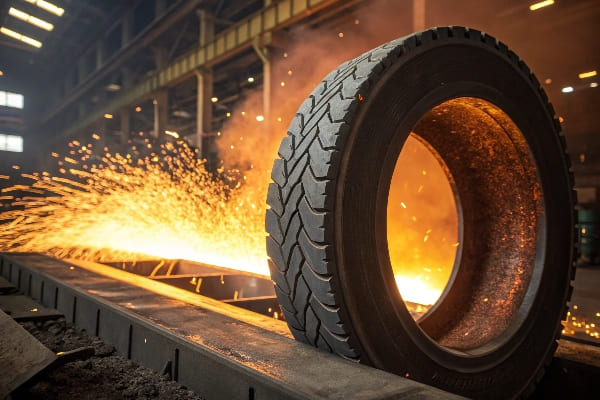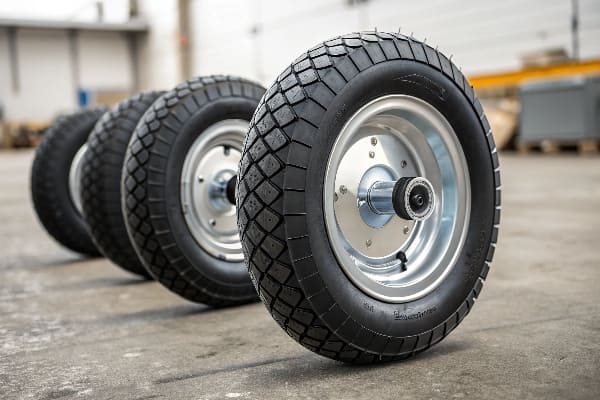Have you ever wondered why sulphur is such an important ingredient in the vulcanization of rubber? Vulcanization is a key process that enhances the performance of rubber, making it more durable and elastic. Sulphur plays a critical role in this process.
Sulphur is used in the vulcanization of rubber to form cross-links between the polymer chains, creating a stronger, more flexible material that resists wear, temperature, and chemical degradation. This chemical bonding is what transforms rubber into the durable and elastic material we use in everyday products.

Let’s explore the role of sulphur in vulcanization, how it affects rubber’s properties, and why this process is so essential for rubber products.
What Is Vulcanization?
Vulcanization is a chemical process that involves the addition of sulphur to raw rubber.
During vulcanization, sulphur atoms form cross-links between the polymer chains in the rubber. This cross-linking process changes the molecular structure of rubber, making it stronger, more elastic, and heat-resistant. The vulcanized rubber becomes less sticky and more durable, which is essential for applications like tires, seals, and footwear.
Key Steps in Vulcanization ✅
| Step | Description |
|---|---|
| Mixing | Sulphur and other additives are mixed with raw rubber |
| Heating | The mixture is heated to initiate the cross-linking process |
| Cross-linking | Sulphur atoms form bonds between rubber polymer chains |
| Cooling | The vulcanized rubber is cooled, solidifying its new structure |
The vulcanization process1 is essential for giving rubber its final properties, ensuring it performs well under various conditions.
How Does Sulfur Make Rubber Tighter?
Sulfur2 plays a key role in making rubber "tighter" by creating cross-links3 between individual polymer chains.
When sulphur is added to raw rubber and the mixture is heated, it forms sulfur bridges or cross-links between the long chains of rubber molecules. These cross-links make the rubber more cohesive and compact, reducing its softness and increasing its strength. This tightening of the polymer structure allows rubber to resist deformation under stress and makes it less prone to wear and aging.
Effects of Sulfur Cross-Linking on Rubber ✅
| Effect | Result on Rubber Properties |
|---|---|
| Tighter Polymer Chains | Increased strength, reduced softness |
| Cross-linking | Enhanced elasticity and durability |
| Reduced Deformation | More resistant to wear and tear |
The cross-linking process "tightens" the rubber’s molecular structure, providing it with more durability, strength, and resilience.
How Does Sulphur Affect Rubber in Vulcanization?
Sulphur is the key ingredient in vulcanization because it creates the chemical bonds that turn raw rubber into a functional material.
When sulphur is added to rubber and the mixture is heated, it forms bridges or cross-links between the individual polymer chains. These cross-links enhance the rubber’s mechanical properties, including its strength, elasticity, and resistance to heat, aging, and chemicals.
Benefits of Sulphur Cross-Linking ✅
| Property | Benefit from Sulphur Cross-Linking4 |
|---|---|
| Elasticity | Rubber becomes more elastic and stretchable |
| Durability | Increased resistance to wear, tear, and aging |
| Heat Resistance | Rubber can withstand higher temperatures without degradation |
| Chemical Resistance | Enhanced resistance to oils, fuels, and other chemicals |
Sulphur cross-linking is the reason why vulcanized rubber is so durable and versatile in a wide range of applications, from tires to medical devices.
What Would Happen Without Sulphur in the Vulcanization Process?
Without sulphur, rubber would remain a sticky, soft, and flexible material, but it would lack the strength and resilience needed for most practical applications.
Rubber without sulphur vulcanization would be too soft and prone to deformation under stress. It would also be more susceptible to environmental factors like heat, cold, and moisture, which would lead to rapid deterioration. By introducing sulphur, rubber becomes a more robust material capable of withstanding tough conditions.
Properties of Unvulcanized Rubber ✅
| Property | Without Sulphur (Unvulcanized) |
|---|---|
| Elasticity | High, but limited by softness |
| Durability | Poor, prone to wear and tear |
| Heat Resistance | Low, easily degrades at high temperatures |
| Chemical Resistance | Low, susceptible to oils and chemicals |
The lack of cross-linking would mean that rubber could not handle the demanding applications for which it is typically used.
Why Is Vulcanized Rubber Preferred for Tires?
Vulcanized rubber, made using sulphur, is essential in tire manufacturing because of its high durability and elasticity.
Tires are subjected to extreme conditions, including high temperatures, pressure, and abrasion. The strength, elasticity, and durability provided by sulphur cross-linking make vulcanized rubber the ideal material for tires, as it ensures they last longer, maintain grip, and withstand the harsh conditions of driving.

Importance of Vulcanized Rubber5 in Tires ✅
| Property | Benefit in Tires |
|---|---|
| Durability | Longer lifespan under stress and wear |
| Elasticity | Better grip and flexibility |
| Heat Resistance | Rubber remains stable under high temperatures |
| Chemical Resistance | Resists degradation from oils and road chemicals |
Tires made with vulcanized rubber provide safety, performance, and longevity, making them essential for all types of vehicles.
What Other Applications Use Vulcanized Rubber?
Vulcanized rubber is used in a wide variety of industries due to its superior properties.
Apart from tires, vulcanized rubber is used in automotive seals, industrial hoses, conveyor belts, footwear, and medical devices. The durability, flexibility, and resistance to wear make vulcanized rubber ideal for these applications, where high performance is critical.
Applications of Vulcanized Rubber6 ✅
| Application | Use of Vulcanized Rubber |
|---|---|
| Automotive | Tires, seals, gaskets |
| Industrial Equipment | Conveyor belts, hoses, seals |
| Footwear | Shoe soles, insoles |
| Medical Devices | Rubber tubing, gaskets |
Vulcanized rubber’s ability to withstand high pressure, temperature fluctuations, and wear makes it a vital material in numerous industries.
Conclusion
Sulphur is an essential ingredient in the vulcanization of rubber, as it creates the chemical bonds that turn raw rubber into a durable, elastic material. By forming cross-links between polymer chains, sulphur enhances rubber’s strength, elasticity, heat resistance, and durability. This process makes rubber suitable for demanding applications like tires, seals, and medical devices, ensuring long-lasting performance.
🚀 Need High-Performance Vulcanized Rubber Products?
Contact Julong Rubber today or Request a Custom Quote for high-quality vulcanized rubber solutions tailored to your industry needs!
Discover the significance of the vulcanization process in rubber manufacturing and its impact on performance. ↩
Explore how sulfur enhances rubber's strength and durability, making it essential in various applications. ↩
Learn about the advantages of cross-links in rubber, including increased strength and reduced deformation. ↩
Explore the advantages of sulphur cross-linking to understand its critical role in enhancing rubber properties for various applications. ↩
Learn why vulcanized rubber is essential for tire manufacturing, ensuring safety and performance under extreme conditions. ↩
Discover the diverse uses of vulcanized rubber across industries, highlighting its versatility and performance benefits. ↩






